Abstract
Direct digital manufacturing of continuous fiber-reinforced thermoplastics exhibits the potential to relieve many of the constraints placed on the current design and manufacture of composite structures. At present, the additive manufacturing of continuous fiber-reinforced thermoplastics is demonstrated to varying extents; however, a comprehensive investigation of manufacturing defects and the quality of additively manufactured high fiber volume fraction continuous fiber-reinforced thermoplastic composites is limited. Considering the preliminary nature of the additive manufacturing of continuous fiber-reinforced thermoplastics, composites processed in this manner are typically subject to various manufacturing defects, including excessive void content in the thermoplastic matrix. Generally, quality evaluation of processed composites in the literature is limited to test methods that are largely influenced by the properties of the continuous fiber reinforcement, and as such, defects in the thermoplastic matrix are usually less impactful on the results and are often overlooked. Hardware to facilitate the direct digital manufacturing of continuous fiber-reinforced thermoplastic matrix composites was developed, and specimens were successfully processed with intentionally varied void content. The quality of the additively manufactured specimens was then evaluated in terms of the measured maximum storage modulus, maximum loss modulus, damping factor and the glass transition temperature by means of dynamic mechanical analysis (DMA). DMA allows for thermomechanical (i.e., highly matrix sensitive) evaluation of the composite specimens, specifically in terms of the measured elastic storage modulus, viscous loss modulus, damping factor and the glass transition temperature. Within the tested range of void contents from roughly 4–10%, evaluation by DMA resulted in a distinct reduction in the maximum measured storage modulus, maximum loss modulus and glass transition temperature with increasing void content, while the damping factor increased. Thus, the results of this work, which focused on the effect of void content on DMA measured properties, have demonstrated that DMA exhibits multi-faceted sensitivity to the presence of voids in the additively manufactured continuous fiber-reinforced thermoplastic specimens.
1. Introduction
A variety of methods for the additive manufacturing of continuous fiber-reinforced thermoplastic matrix composites have been described [1,2,3]. Consistent with the variety of methods employed in the literature to additively manufacture continuous fiber-reinforced thermoplastics, there exists a vast spectrum of processed composite material fiber volume fractions and quality described as well. As the relevant literature has yet to come to a substantive conclusion on what constitutes acceptable processed material quality relative to this developing technology, the current work will discuss processed composite material quality, qualitatively and quantitatively, specifically in terms of reinforcement distribution in the thermoplastic matrix, reinforcement content by volume (fiber volume fraction) and void content by volume.
In consideration of the processed material quality common in the relevant literature, it would seem logical that the literature would also exhibit a variety of different quality evaluation techniques employed to target and quantify the effects of quality variation; however, as will be discussed, this is not the case. The literature concerning the additive manufacturing of continuous fiber-reinforced thermoplastics largely relies on tensile loading to failure as a quality evaluation tool [4,5,6,7,8,9,10,11,12]. For example, tensile loading to failure in fiber dominated tensile test configurations is apparent in a variety of works where fiber volume fractions range from as low as 1% to as high as 40%, where discrete bundles of the continuous reinforcement are readily distinguishable and void content by volume is either only qualitatively expressed or disregarded entirely [4,6,7,11].
Despite the fact that tensile loading to failure may allow for the empirical determination of the ultimate tensile strength for additively manufactured continuous fiber-reinforced thermoplastics, the ultimate tensile strength is a fiber dominated property that is shown to, at least in more traditional carbon fiber/epoxy laminates, be only moderately affected by gross void content in the polymer matrix [13]. In addition to examining the dependence of tensile and compressive failure loads relative to void content in carbon fiber/epoxy laminates, the dependence of interlaminar properties on gross void content was also examined [13]. In contrast to the weak tensile and compressive properties dependence on void content that was reported, a significant dependence of the composite interlaminar properties on void content was observed for these relatively brittle epoxy matric composites. A reduction of approximately 25% in short-beam strength with an approximate 6% increase in void content was measured for these thermoset matrix composites [13]. Thus, it should be clear that tensile loading to failure, in the fiber direction, is inadequate in terms of evaluating the quality, as it pertains to manufacturing defects of additively manufactured continuous fiber-reinforced thermoplastic matrix composites.
Based on the literature on carbon fiber/epoxy laminates, it would then seem reasonable to investigate consolidation quality and void content in additively manufactured unidirectional continuous fiber-reinforced thermoplastic composite beams using short beam shear (SBS) testing as described in ASTM D2344 [14]. Unfortunately, in previous efforts carried out by the authors, all relevant SBS tests of unidirectionally reinforced thermoplastic matrix composites resulted in inelastic failures, where the specimen permanently deforms, as seen in Figure 1, but does not show catastrophic interlaminar shear failure. The SBS test results were insensitive to the measured thermoplastic matrix void content, showing no consistent trend in SBS strength over a range of 2–6% void content and, as a result, short-beam strength is an ineffective indicator of composite quality when inelastic failure occurs [15].
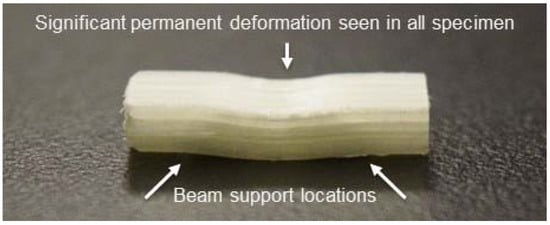
Figure 1.
A 50% fiber volume fraction continuous E-Glass fiber/Polypropylene SBS test coupon.
Other means of mechanical performance-based quality evaluation are documented in the literature but to a lesser extent. Interlaminar mechanical evaluation, as well as flexural mechanical evaluation, were employed; however, their use was generally limited to the comparison of relative process parameter effects on the processed composite material or for comparison to neat polymer specimens [3,7,8,9,10,12]. In addition to interlaminar and flexural mechanical evaluation, the literature indicates that other mechanical evaluation methods, including Charpy impact testing, tensile and flexural fatigue to failure measurements and quasi-static indentation, were employed [9,10,12]. Again, it is emphasized that the primary use of these techniques was exclusive of any quantitative commentary on either reinforcement distribution or void content.
In contrast to the quasi-static mechanical testing that is common in the literature, with the exception of [10], the use of dynamic mechanical analysis (DMA) was seldom employed to investigate consolidation quality, or void content, in thermoplastic matrix composites [6,7]. DMA can most readily be described as a thermomechanical analysis technique where a specimen is cyclically loaded, in tension, compression, flexure, shear or torsion, while the viscoelastic response of the specimen is measured, typically over a range of temperatures. DMA was shown to be effective in the evaluation of both neat polymers as well as polymer matrix composites, as it is capable of providing both quantitative and qualitative information about the viscoelastic response of the material. The viscoelastic response that is measured via DMA is most commonly expressed in terms of the storage modulus, E’ (elastic response), the loss modulus, E” (viscous response), the loss tangent or damping factor (the ratio of E” to E’, commonly tan δ) and the glass transition temperature (Tg).
Despite the abundance of viscoelastic material data that can be developed via DMA, it was primarily utilized in the literature for the purpose of quantifying the glass transition temperature of the additively manufactured continuous fiber-reinforced thermoplastics [6,7]; however, a notable exception should be acknowledged [7]. That study focused on assessing the effects of fiber surface modification, specifically to facilitate the development of intimate fiber/matrix contact and strong interface generation, on the mechanical performance of additively manufactured continuous carbon fiber-reinforced polylactic acid (PLA) composites. The effects of the fiber surface modification were reported in terms of specimen storage modulus, loss tangent and glass transition temperature, where substantive differences in the viscoelastic performance of printed composites with the modified fibers were recorded as compared to printed composites with un-modified fibers [7]. The work attributed these results to the enhanced interfacial bond, and subsequent load transfer, in the printed composites utilizing the modified reinforcement, as well as the lack of interfacial bonding and the likely presence of manufacturing defects, namely voids along the interface, in the composite specimen with untreated reinforcement [7].
Although DMA was only minimally utilized as a quality evaluation tool with respect to the additive manufacture of continuous fiber-reinforced thermoplastics, the work in the literature on fiber-matrix modification clearly suggests that DMA is sensitive to process-related quality variations [7]. The current effort focuses on assessing the effects of void content on the thermomechanical performance of additively manufactured high volume fraction, continuous fiber-reinforced thermoplastic matrix composites.
2. Experimentation
Specimens with intentionally varied amounts of void content were additively manufactured and subjected to dynamic mechanical analysis for the purpose of aiding the development of an understanding of the effects of manufacturing defects, in this case, void content, on the quality of the processed composite materials.
2.1. Materials
The feedstock material employed in this work is a continuous commingled roving, Compofil PET-70-R2690N (Jushi USA Fiberglass Co., Ltd., Irwindale, CA, USA), which is composed of continuous E-Glass fibers in parallel with continuous, transparent PET thermoplastic fibers at a ratio of 70% glass fiber by weight (nominally 55% by volume). Documented in prior work [1], differential scanning calorimetry (DSC) was used to determine the glass transition region of the PET thermoplastic in this commingled product. In addition to verifying an amorphous microstructure, the prior work determined a nominal mid glass transition temperature of 71.5 °C for the PET thermoplastic [1]. An adhesive-back polyimide film, 0.05 mm thickness, was used as the deposition surface to provide sufficient tack to secure the deposited continuous fiber-reinforced thermoplastic material to the heated aluminum print bed.
2.2. Fiber Placement and Consolidation Hardware
The general configuration of the manufacturing equipment employed in this effort is that of a fused filament deposition 3D printing system. The specific configuration used in this research is a custom developed 3-axis gantry-based automation system with a build volume of approximately 300 mm × 600 mm × 300 mm. The system makes use of many commercially available 3D printing components as the basis for the extrusion system. To process the dry commingled feedstock and create a continuous fiber-reinforced composite, the feedstock must travel through the heated zone and nozzle so that the PET fibers flow. Then, by fixing the end of the heated tow to the build surface and moving the printhead across the print bed, along a preprogrammed path, the E-Glass fiber-reinforced material is pultruded, along with the PET matrix. As the system positions the material, the face of the nozzle is positioned to apply pressure, forcing the fiber-reinforced PET against the build surface and generating the desired degree of consolidation in the composite. The rudimentary end-effector configuration, shown in Figure 2, is meant to clearly indicate the technique utilized to convert the dry commingled fiber into a rigid, consolidated E-Glass fiber/PET matrix composite. However, this basic end effector was highly modified for the current effort.
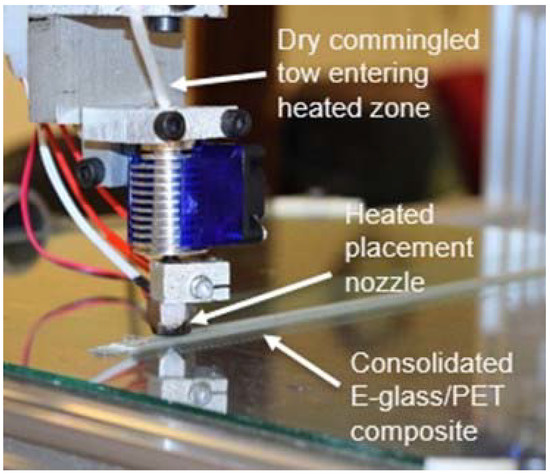
Figure 2.
Schematic of commingled tow extrusion and consolidation.
The purpose-built fiber placement and consolidation hardware used in this work integrates a highly modified end effector. While the end effector used has the same basic components as those shown in Figure 2, the assembly incorporates a spring-loaded extruder mounting system [1]. An overview of the system, including the spring-loaded end effector, is pictured in Figure 3. The end effector utilizes a steel compression spring of known stiffness (~7.5 N/mm) to allow for the application of a programmable consolidation force. By programming a negative height above the build surface, the placement nozzle face is pushed into the surface, displacing the spring, resulting in a known consolidation force. The heated nozzle used in this research is similar in concept to a common 3D printer extruder nozzle but is of a specialized design which includes an inner diameter that the commingled tow passes through, of a nominal 1.4 mm. In addition, this specialized nozzle has a large flat face, with an outer diameter of approximately 11.5 mm, enabling the application of the consolidation force to the tow at the point of material deposition, as seen in Figure 3a,b and described more completely in previous publications [1,15,16]. In addition to the spring-loaded end effector, a rigidly mounted surface was used as the build plate, as seen in Figure 3c. With this rigid print bed affixed to the machine frame and vertically supported by the workbench the machine rests on, the overall compliance of the print bed was reduced to a point where the contribution to the system spring rate was deemed negligible.
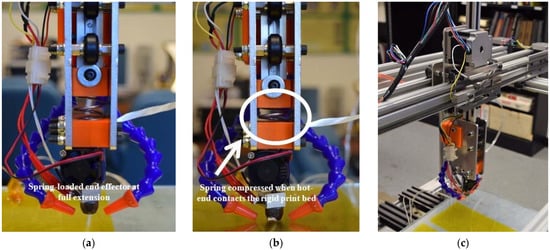
Figure 3.
Spring-loaded end effector (a) at full extension (b) under compression in contact with the rigid print bed and (c) mounted on the 3-axis gantry system.
Once relevant layer geometry (width and thickness) was developed empirically, in a method consistent with the earlier work, displacement control in the build direction (Z) allowed for the application of a near constant consolidation force during processing. Near constant consolidation force during processing is possible by means of programmed spring displacements that far exceed any small variations in the displacement of the spring as the print head moves across any irregularities in the surface of the sample. Using programmed spring displacements in the range of 1–2 mm, and assuming small variations in the displacement of the spring during printing (<0.1 mm), total force variation was assumed to stay within the realm of ~1 N. In early proof-of-concept testing of the spring-loaded end effector, no spring movement during printing was visible; therefore, the assumption of negligible variations in the displacement of the spring during printing was deemed tenable [15]. Consistent consolidation pressure during a multilayer build is achieved by lifting the end effector an amount equal to the layer thickness as each subsequent layer is applied. Two adjustable cooling ducts, oriented to point at the tip of the nozzle, are shown in Figure 3. Cooling ducts, which supplied compressed air, were included in the design of the spring-loaded end effector as a means of quickly rigidizing the commingled material after deposition on the print bed.
2.3. Process Parameters
Process parameters for this study were based on prior experience using the continuous E-Glass and PET fiber commingled precursor coupled with the additive manufacturing (AM) system relevant to this work [15]. There are three primary process variables that can be modified to functionally change the quality of the composite material, (i) extruder temperature, (ii) applied consolidation force and (iii) print speed. For this effort, the concept was to generate a variety of void contents by changing the print speed and thus the effective consolidation time while holding the other process variables constant. Confidence in this approach was gained from a study concerned with the effects of void content on the flexural performance of unidirectional glass fiber-reinforced polypropylene which varied the time under consolidation pressure, albeit in a compression molding type process, to produce thermoplastic matrix composites with void contents ranging from 1–14% [17].
2.4. Specimen Preparation
To investigate the effect of material deposition rate on the resulting composite quality, a series of specimens were prepared according to geometric constraints placed on the specimen by both the dynamic mechanical analysis (DMA) test chamber and the corresponding test fixture. The DMA used for this work was a Seiko DMS6100, with a cylindrical test chamber interior geometry defined by a 78 mm height and a 64 mm diameter. The fixture relevant to this work is a double cantilever beam bending device (DCB or clamped-clamped bending) with an outboard clamp to outboard clamp span of 50 mm, maximum clampable width of 15 mm and maximum clampable thickness of 5 mm. These dimensions represent absolute maximums for a clampable specimen geometry. In this fixture, the specimen is rigidly clamped at its lengthwise extremities as well as at the specimen mid-span, where the mid-span (in-board) clamp is rigidly connected to the moving loading shaft of the DMA. The free length of the specimen on each side of the in-board clamp is 10 mm, resulting in a total tested length of 20 mm. The clamped-clamped bending fixture is shown in Figure 4.
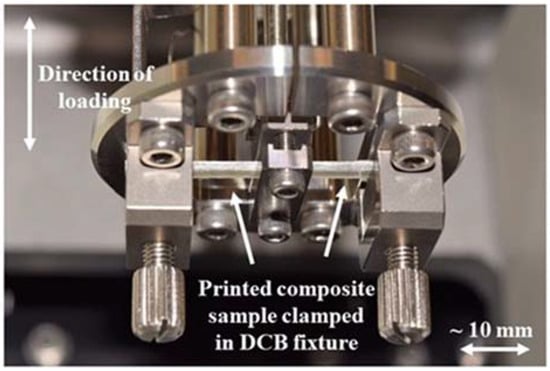
Figure 4.
Printed composite sample in the double cantilever beam fixture relevant to this work.
Continuous E-Glass fiber/PET beams of rectangular cross-section were processed from the commingled feedstock using seven print speeds, ranging from 100–400 mm/min in increments of 50 mm/min, while all other process parameters were held constant. Print temperature was held constant at 220 °C with the cooling ducts enabled, print bed temperature was held constant at 72 °C, just above the nominal Tg value determined, by DSC, for the PET thermoplastic in the commingled precursor. The applied spring force for consolidation was held constant at 9 N via the use of control code-based displacement control of the end effector, resulting in a programmed printed layer height, and thus a resulting fiber-reinforced layer thickness of approximately 0.4 mm. Specimens were printed such that the specimen cross-section was comprised of four unidirectional (UD) printed plies of the continuous commingled precursor, placed one on top of another, creating unidirectional (UD) laminated beams nominally 1.5 mm thick. A close-up view of the extrusion and consolidation process is shown in Figure 5.
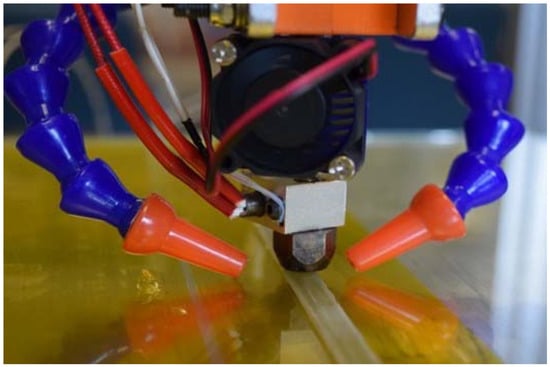
Figure 5.
Close up of the extrusion and consolidation of a test specimen.
As a result of printing the samples at varying print speeds, analogous to varying the time under consolidation pressure, the nominal sample thickness increased as a function of increasing print speed. This is a trend consistent with other works in the literature [17,18]. This trend is intuitive under the assumption that the viscous flow of the thermoplastic polymer in the commingled material, in the low viscosity state experienced during processing, occurs almost entirely due to mechanical force applied by the spring-loaded end effector via the heated nozzle. This implies that the slower print speeds, with all other parameters held constant, will generally correspond to thinner samples. A slow print speed provides a longer period of time for the low viscosity polymer to flow laterally away from the nozzle outlet. Consequently, the changes in sample thickness with print speed were accompanied by changes in the sample width. As the thickness of each ply increased with increasing print speed, the width of the ply decreased accordingly. This concept is illustrated graphically in Figure 6, where under otherwise equal processing parameters, Figure 6a correspond to higher print speeds and less consolidation. In comparison, Figure 6b is indicative of lower prints speeds.
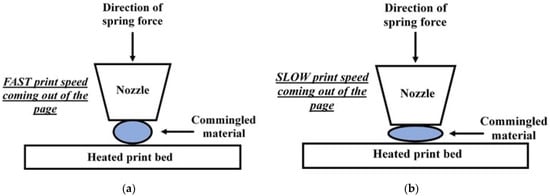
Figure 6.
Graphical representation of correlation between print speed (a) higher print speed, (b) lower print speed, and layer cross-section according to viscous flow of the thermoplastic.
All beam specimens were printed to have an approximate total length of 120 mm. A single DMA test specimen, of 60 mm length was cut from the mid-section of each 120 mm beam. This method provides test specimens from the portion of the beam that is produced under a steady-state print speed, and thus under consistent consolidation, removing material produced during transients as the system accelerates and decelerates.
A total of 10 continuous E-Glass/PET specimens were printed at each print speed, with 6 being used for DMA testing and the remainder for metallographic investigation. Following trimming to the 60 mm length, all specimens were sanded, using 400 grit SiC paper, along the length of the vertical edges (1.5 mm thickness) to provide a pseudo-planar surface for subsequent specimen width measurements. Sanding along the top and bottom of the specimens was not required as the surface finish of both top and bottom surfaces of the specimen were effectively molded during printing by the print bed and the consolidation face of the hot-end fiber placement nozzle.
Specimen cross-section dimensions were measured with a digital micrometer. Four measurements of specimen width and thickness were taken along the length of the beam and averaged. An example of an as-printed beam specimen compared to a post-processed DMA specimen is shown in Figure 7. The average dimensions of each group of DMA specimens (seven total groups, each composed of six specimens), separated by print speed, are reported in Table 1.

Figure 7.
As-printed E-Glass/PET beam as compared to a post-processed DMA specimen.

Table 1.
Average dimensions of each group of DMA specimens with standard deviations.
2.5. Test Procedures
Manufactured specimens were visually inspected. The degree of translucency is a useful indicator of the fiber wetout and internal defects. A more translucent specimen suggests that there is good wetout of the fiber by the PET matrix material and few voids, while an opaque specimen indicates trapped air inside the specimen. Metallographic techniques were also employed to image the cross-sections of representative regions of the printed specimens to verify the consistency of the fiber distribution.
2.5.1. Dynamic Mechanical Analysis
Based on ASTM D4065-12 [19], DMA tests were performed using a clamped–clamped double cantilever configuration. Specimens for testing were cut from the as-printed beams such that the continuous E-Glass fiber reinforcement spanned the length of the specimen. The test protocol was performed over the temperature range from 30 °C to 90 °C at a heating rate of 5 °C per minute, with a frequency of 1 Hz. A heating rate of 5 °C per minute was chosen as it provides relatively short scan times of roughly 12 min per scan, and yet is slow enough to expect reasonably constant material temperatures given the specimen size.
It is generally accepted that the maximum oscillatory strain to remain within the linear viscoelastic range, as specified by ASTM D4065-12, is less than 0.01 mm/mm. For the purpose of this effort, a nominal strain of 0.005 mm/mm was chosen to ensure the test was performed well within the linear viscoelastic range. Equation (1) was applied to determine the mid-span displacement that would be utilized to generate the 0.005 mm/mm nominal strain.
For Equation (1), ‘ε’ represents oscillatory strain, ‘a’ represents maximum beam displacement, ‘t’ represents nominal DMA specimen thickness and ‘l’ represents the unclamped or free length of one half of the double cantilever specimen. For the current double cantilever beam test geometry, where ‘l’ = 10 mm and using the test specimen dimensions given in Table 1, a 25 μm mid-span specimen displacement translates to a maximum oscillatory strain in the range of 0.0040–0.0052 mm/mm, depending on nominal sample thickness. Thus, 25 μm was used as the programmed mid-span displacement for all tests. Maximum values of the storage modulus (E’), loss modulus (E”) and damping factor (tan δ) were determined directly from the DMA output.
The glass transition temperature (Tg) was also of interest as a potential indicator of void content. Typical methods to determine the glass transition temperature include using the onset of the increase in the tan δ curve, the peak of the tan δ curve, the onset of the E’ drop, the onset of the increase in the E” curve or the peak of the E” curve [20]. Choosing a method for the determination of Tg is largely dependent on idiosyncrasies that relate to the particular goals of the relevant study, coupled with the background of the experimentalist. The relevant ASTM Standard for the determination and reporting of dynamic mechanical properties, ASTM D4065, recommends using the peak of the tan δ as general practice, while also acknowledging that the other phenomena previously described can also indicate the glass transition temperature [19].
For the purpose of this work, the glass transition temperature was determined as the temperature at the maximum magnitude of the E” curve at 1 Hz. Literature concerning the correlation between both DMA and differential scanning calorimetry (DSC)-based methodologies for determining the glass transition temperature of polymers indicates that choosing Tg based on the maximum value of the loss modulus (E”), explicitly at 1 Hz, corresponds well with the mid-Tg observed in DSC [21]. For reference, it was reported that, in isolated cases, differences between Tg determined from the maximum E” and the mid-Tg from DSC can be as much as ±10 °C; however, it should be noted that there is a much poorer correlation between the mid-Tg from DSC and the Tg as determined by the peak of the tan δ curve [21].
2.5.2. Constituent Material Content Tests
Volume fraction evaluation of all six specimens of each of the seven print speeds was performed in accordance with ASTM D3171 [22]. Each specimen was dried in a desiccator and weighed prior to determining the composite density via the Archimedes method. For this density determination, specimens were painted on all sides with a thin acrylic coating, of known density, prior to density measurement. This was conducted to seal any open surface porosity and mitigate water uptake in the specimens. Specimens were weighed following the application of the acrylic coating, and as such, the volume of the acrylic coating was accounted for in the relevant calculations. Following composite density determination, the PET matrix from each sample was pyrolyzed in a muffle furnace in air for 5 h at 550 °C, leaving only the continuous E-Glass reinforcement. The glass fiber reinforcement was then weighed, and constituent volume fractions (fiber, matrix and void) were determined based on constituent densities for the commingled precursor material provided by the manufacturer. The constituent density values used in all void fraction calculations were 2.62 g/cm3 for the E-glass fibers and 1.27 g/cm3 for the PET fibers.
3. Results
The E-Glass fiber reinforced PET beams produced at different print speeds have obvious visual differences, as shown in three representative specimens in Table 2. Specimens that are well consolidated, with minimal voids and other internal defects, are expected to be translucent due to similar refractive indices of the constituent materials. As the void content and associated internal defect content increase, specimens become less translucent. A decreasing degree of translucency is noted as the material deposition speed increases from 100 mm/min to 400 mm/min. This suggests reduced quality as the deposition speed increases.

Table 2.
Visual comparison of representative DMA specimens before testing.
3.1. DMA Double Cantilever Beam Results
A total of 42 beam specimens were evaluated in the DMA. The maximum measured storage modulus (E’), loss modulus (E”), damping factor (tan δ) and the glass transition temperature (Tg) were determined from the DMA output for each of the six specimens belonging to each of the seven print speed-based specimen groups. The average of the maximum measured moduli from the 1Hz frequency sweep and the associated standard deviations are plotted against print speed in Figure 8. The damping factor, tan δ, is plotted against print speed in Figure 9, and the glass transition temperature (Tg), measured from the peak of E”, is correspondingly plotted against print speed in Figure 10. The values of the standard deviation are shown as error bars in each chart.
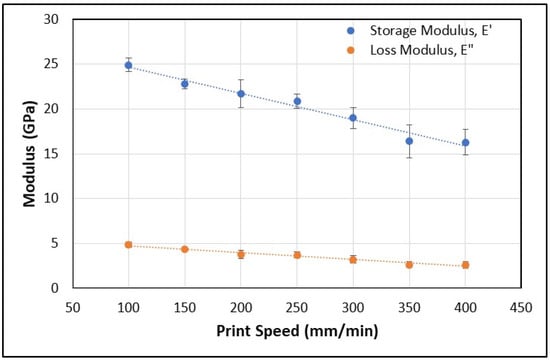
Figure 8.
Storage modulus and loss modulus data vs. print speed.
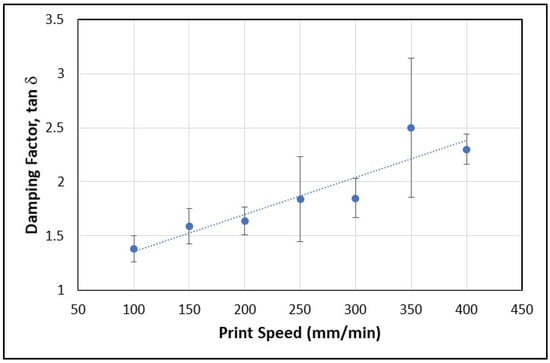
Figure 9.
Damping factor (tan δ) data vs. print speed.
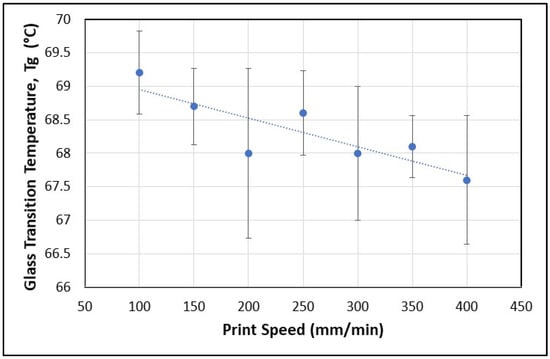
Figure 10.
Glass transition temperature (Tg) data vs. print speed.
The DMA results indicate a decreasing trend in the maximum values of the storage modulus, the loss modulus and the glass transition temperatures with increasing print speed. The damping factor shows an increasing trend with print speed. Since the qualitative evaluation of the specimens suggested that the consolidation quality decreases with increasing print speed, the DMA data suggests that these same trends correlate with changes in void fraction. However, to quantify the changes in consolidation quality, determination of the void content is necessary.
3.2. Constituent Content versus Print Speed
The fundamental assumption made in this work was that void content in the printed composites is related to changes in the print speed while holding extruder temperature and consolidation force constant. Visual examination clearly suggested a decrease in quality with increasing fiber placement rate (print speed). Once the DMA testing was complete, each of the 42 specimens was prepared for Archimedes evaluation and subsequent pyrolysis. The resulting values of constituent content based on ASTM D3171 are presented in Figure 11.
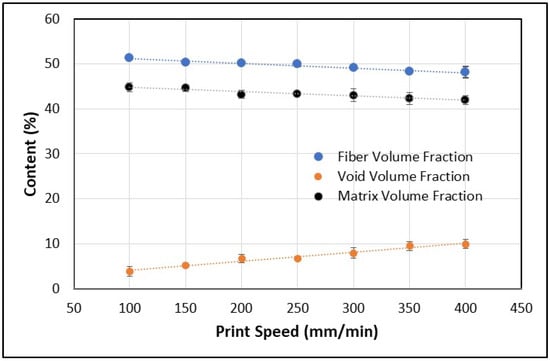
Figure 11.
Fiber, matrix and void content versus print speed.
The results shown in Figure 11 clearly indicate a trend of increasing void content in the printed continuous fiber-reinforced composites with increasing print speed, which is consistent with the visual examination. The void fractions range from a minimum of 3.85% at 100 mm/min to a maximum of 9.9% at 400 mm/min. The corresponding drop in fiber volume fraction and matrix volume fraction with increasing print speed is consistent with the increase in void content, suggesting poorer consolidation. The complete tabulated data for the DMA tests and constituent content measurements are given in Table 3.

Table 3.
DMA data at 1 Hz and constituent content related to print speed.
3.3. Metallographic Evaluation
Measurement of void content in the as-tested DMA specimens requires complete consumption of the specimens in a high temperature muffle furnace, leaving only the continuous reinforcement behind, and as such, metallography of the as-tested specimens is impossible. Thus, additional specimens for each of the print speed specimen groups were additively manufactured during the specimen preparation phase and allocated for use as representative metallographic samples. Representative cross-sectional micrographs from the slowest, fastest and intermediate print speed specimen group are included in Figure 12. These micrographs are used only as a qualitative tool to assess the previously reported void contents in the printed DMA specimens and to investigate the position and distribution of the voids. It is worth noting that, even at the two extremes of print speed, pseudo-homogenous reinforcement distribution in the thermoplastic matrix is demonstrated, as shown in Figure 12a, 100 mm/min, and Figure 12c 400 mm/min.
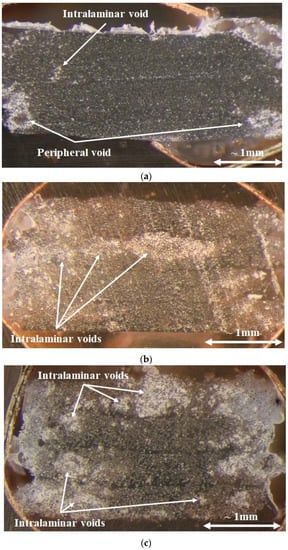
Figure 12.
Representative DMA cross-sections for geometry and void content comparison (a) 100 mm/min, (b) 250 mm/min, (c) 400 mm/min.
Examination of the three cross-sections shown in Figure 12 yields an immediate visual correlation between the extremes of the print speed used to additively manufacture the representative specimens and the void content therein. Consistent with the measured trends of increasing void content with print speed documented in Figure 11 and Table 3, the void content in the specimen produced at 400 mm/min, shown in Figure 12c, is visibly greater than that of the 100 mm/min specimen, shown in Figure 12a. The micrograph of the specimen produced at 250 mm/min, shown in Figure 12b, indicates an intermediate quality, giving some sense of the transition in void content with print speed. In each case, much of the void content is in intralaminar regions and the periphery of the representative specimens. However, in addition, the intertow (interlaminar) boundaries seem much more pronounced in the specimen printed at 400 mm/min, which is consistent with a reduction in consolidation effectiveness.
4. Discussion
The results shown indicate a relationship between composite quality and print speed. The values of the maximum storage modulus, E’, the maximum loss modulus, E”, and the glass transition temperature, Tg, showed similar trends of decreasing values with increasing print speed, as indicated by the trends displayed in Figure 8 and Figure 10. The damping factor, tan δ, showed the opposite trend, increasing with increasing print speed, as seen in Figure 9. The void content was also shown to increase with print speed, as seen in Figure 11. However, to better investigate these trends, it is necessary to consider the DMA results and the measured void content. To better visualize the direct relationships between E’, E”, tan δ and Tg and the void content, the data is replotted, in terms of DMA results versus void content, in Figure 13, Figure 14, Figure 15 and Figure 16. The maximum measured storage modulus data, determined as a function of void content, is presented in Figure 13 with associated error bars indicating the standard deviation of the six samples measured at each of the seven print speeds for both the average maximum storage modulus and the void content.
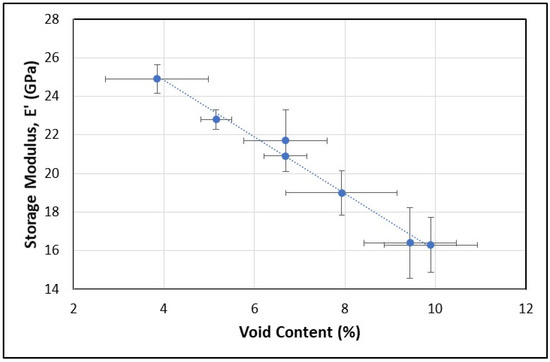
Figure 13.
Storage modulus, E’, versus void content.
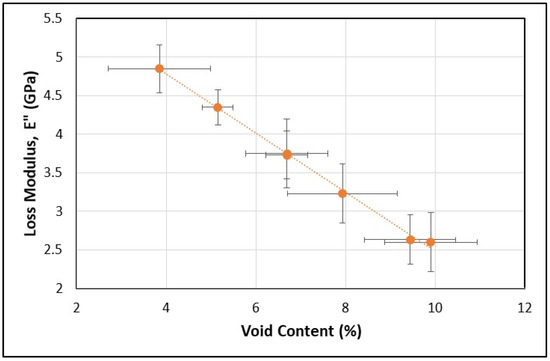
Figure 14.
Loss modulus, E”, versus void content.

Figure 15.
Damping factor, tan δ, versus void content.
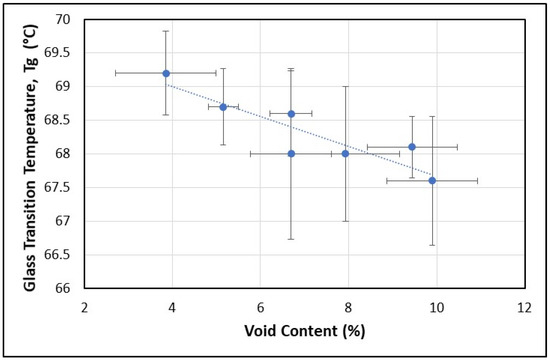
Figure 16.
Glass transition temperature, Tg, versus void content.
When examining Figure 13, it is clear that there is a distinct negative trend in the storage modulus with increasing void content in the printed composite specimens. Further, it is important to realize that the data in Figure 11 also show a decreasing fiber volume fraction with print speed. This indicates that the decreasing E’ can also be correlated to the reduced fiber volume fraction. It should be noted that at a void content of approximately 6.7%, there are two values of storage modulus. These two points represent the print speeds of 200 and 250 mm/min. The standard deviations of these two storage modulus values overlap, making it difficult to separate them; however, even though the effective consolidation was not different for these two cases, a linear trendline of storage modulus with void content still fits the data collected, falling within the error bars related to the associated standard deviations. Based on the data presented, the measured average values of the maximum storage modulus decrease by approximately 33%, with close to a 6% increase in void content. This decrease in the maximum measured storage modulus translates to an approximate 5% decrease, or almost a 1.5 GPa drop per 1% added void content.
The average of the maximum value of the measured loss modulus, E”, was also determined for each of the seven print speed specimen groups along with the associated standard deviations. In this research, the maximum measured loss modulus was observed in the glass transition region of the DMA temperature sweep and can also be used as an indicator of the glass transition temperature [20,23]. More generally, the loss modulus serves as a representation of the ability of a polymer to dissipate strain energy as heat through internal motions. In consideration of the relevant DMA literature, it is not uncommon for studies to report differences in the maximum measured loss modulus for the same temperature at which the maximum E” is measured; however, it is uncommon to see commentary on the significance of the magnitude of E” at its maximum value in the DMA scan. Similar to the format used to present the measured average maximum storage modulus as a function of void content, the measured average maximum values of loss modulus, with associated sample standard deviations, are presented against void content in Figure 14.
Again, a linear trend line was added to Figure 14 for the purpose of showing a seemingly linear relationship in the empirical data within the experimental window. Like the results of the storage modulus, the measured loss modulus data is also subject to two stacked, or vertically coincident, data points at 6.7% void content. As with the prior case, these stacked data points correspond directly to the nominal 200 mm/min and 250 mm/min specimen groups which exhibited nearly identical average void contents. In keeping with the storage modulus trend, the nominal values for measured average maximum loss modulus at these two points lie within the sample standard deviations of each other, and as such, cannot be readily distinguished as being significantly different from one another. Based on the data presented, the measured average values of the maximum loss moduli decrease by approximately 45% with the 6% increase in void content. This decrease in the measured maximum loss modulus translates to an approximate 7% decrease or almost a 0.4 GPa drop per 1% added void content.
At first glance, this decreasing trend of E” with void content seems counterintuitive as damping should seem to increase with increasing void content. However, within the tested temperature range, it is assumed that the viscoelastic material response is heavily influenced by the amorphous PET thermoplastic matrix, as well as the interface between the PET matrix and the continuous E-Glass reinforcement. As such, it is likely that the negative trend in the maximum measured loss modulus, with increasing void content, can be generally related to a combination of the corresponding decreases in both the fiber volume content and the matrix volume content, as seen in Figure 11. This is in addition to the fact that these measured values of maximum E” are taken in the temperature region of the glass transition and far above the temperature of the measured maximum E’. Thus, to better assess the effect of voids on the damping characteristics, it is useful to consider the damping factor, tan δ. The trend of increasing tan δ with void content, shown in Figure 15, is a clear indication of the effect of increasing voids. This increase in the damping factor is consistent with expectations.
Finally, it is important to consider how the glass transition temperature, Tg, as measured from the maximum loss modulus, E”, varies with void content, as shown in Figure 16. Despite the seemingly small range of measured glass transition temperature across the approximately 6% increase in void content, as well as the relatively large sample standard deviations, the negative trend shown in Figure 16 is tenable based on the first (graphically the left-most data point) and last (graphically the right-most data point) data points coupled with their associated standard deviations, which do not overlap. In the relevant literature, it is common to record variations in Tg as a function of small changes to a material that is subjected to dynamic mechanical analysis [7,18,23,24]. Furthermore, the two most relevant articles to this work reported clear shifts in Tg to lower temperatures, with decreased interfacial contact between the constituent reinforcement and matrix as well as increased void content (i.e., manufacturing defects) [7,18].
The fundamental assumption driving this experimental study was that DMA measurements would be more sensitive to variations in void content than other quasi-static mechanical tests such fiber dominated tensile tests or even short beam shear testing. It was also important to understand if DMA would be sensitive enough to serve as a tool to investigate changes in the manufacturing process parameters. The storage modulus, loss modulus and the damping factor results all showed a strong correlation with the void content and the associated print speed. Additionally, the measured trend of decreasing glass transition temperature with increasing voids was consistent with prior efforts. However, it should be noted that the maximum measured storage modulus has a lower standard deviation than that of both the loss modulus and the damping factor and tends to be more consistently determined. Correspondingly, the damping factor, tan δ, determined from the ratio of E”/E’ at the maximum value of E’ demonstrates a consistently increasing trend with void fraction. While the linear trendline suggests a 5% change in storage modulus and a 14% change in the damping factor for each increment of 1% void content, a more conservative approach involves considering the standard deviation in the values of void content. The standard deviations in the void content are greater than those in the DMA measured values, and thus, while the trends of storage and damping factor with void fraction may be clear, the variability in void fraction suggests that the resolution of this approach may be limited by the variability in the void content measurement. This limitation, tied to the method of void content measurement, still does not diminish the potential for this DMA-based approach to serve as a quality evaluation tool, as clear trends exist between the DMA data and both the print speed and void content. To gain further insight into the potential for this technique to assess manufactured thermoplastic matrix composite quality and understand the interrelationships between the three primary process parameters, print speed, consolidation pressure and temperature, future efforts will need to investigate the effects of changing temperature and consolidation pressure on the resulting void content.
5. Conclusions
Unidirectional E-Glass fiber reinforced PET multilayer beams, produced by a continuous extrusion of commingled yarn, were found to have lower void content at lower placement/printing speeds. As the print speed was increased, the void content increased, and there was a corresponding reduction in consolidation quality, as supported by metallographic information. Void contents ranging from 3.85% to 9.90% were measured using a combination of the Archimedes method and matrix pyrolysis. Corresponding fiber volume fractions fell from 51.35% to 48.18% as the speed increased from 100 mm/min to 400 mm/min while maintaining the same extruder temperature and consolidation force. Thus, it has been shown that high volume fraction continuous fiber-reinforced composites can be produced via extrusion in the style of thermoplastic filament extrusion 3D printing with relatively low void fractions. However, the quality of the resulting composite is directly related to the printing speed for a fixed extruder temperature and consolidation force. The results of dynamic mechanical analysis, using a clamped–clamped configuration in a dual cantilever fixture, show a sensitivity to the percentage of manufacturing defects, namely void content in the thermoplastic matrix, in additively manufactured continuous fiber-reinforced thermoplastic matrix composite materials. Dynamic mechanical analysis exhibits multi-faceted sensitivity to the presence of voids in the printed composites, specifically in terms of the maximum measured storage moduli, the damping factor and the glass transition temperature, which is much greater than the sensitivity of previous short beam shear strengths when the composite shows inelastic behavior.
Author Contributions
P.A.R. and D.W.R. were involved in conceptualization, methodology and writing the original draft; P.A.R. was involved in investigation and formal analysis; D.W.R. was involved in writing the review and editing, project administration and funding acquisition. All authors have read and agreed to the published version of the manuscript.
Funding
This research was funded by the State of Colorado, Advanced Industry Accelerator Grant Program, grant number APP-112255.
Conflicts of Interest
The authors declare no conflict of interest.
References
- Rodriguez, P.A.; Radford, D.W. Effect of Applied Consolidation Pressure in Direct Digital Manufacture of Continuous Fiber Reinforced Composites. In Proceedings of the CAMX Conference, Orlando, FL, USA, 12–14 December 2017; pp. 12–14. [Google Scholar]
- Qureshi, Z.; Swait, T.; Scaife, R.; El-Dessouky, H. In situ consolidation of thermoplastic prepreg tape using automated tape placement technology: Potential and possibilities. Compos. Part B Eng. 2014, 66, 255–267. [Google Scholar] [CrossRef]
- Tian, X.; Liu, T.; Yang, C.; Wang, Q.; Li, D. Interface and performance of 3D printed continuous carbon fiber reinforced PLA composites. Compos. Part A Appl. Sci. Manuf. 2016, 88, 198–205. [Google Scholar] [CrossRef]
- Van Der Klift, F.; Koga, Y.; Todoroki, A.; Ueda, M.; Hirano, Y.; Matsuzaki, R. 3D Printing of Continuous Carbon Fibre Reinforced Thermo-Plastic (CFRTP) tensile test specimens. Open J. Compos. Mater. 2016, 06, 18–27. [Google Scholar] [CrossRef] [Green Version]
- Melenka, G.W.; Cheung, B.K.O.; Schofield, J.S.; Dawson, M.R.; Carey, J.P. Evaluation and prediction of the tensile properties of continuous fiber-reinforced 3D printed structures. Compos. Struct. 2016, 153, 866–875. [Google Scholar] [CrossRef]
- Bettini, P.; Alitta, G.; Sala, G.; Di Landro, L. Fused deposition technique for continuous fiber reinforced thermoplastic. J. Mater. Eng. Perform. 2016, 26, 843–848. Available online: http://link.springer.com/10.1007/s11665-016-2459-8 (accessed on 27 January 2017). [CrossRef]
- Li, N.; Li, Y.; Liu, S. Rapid prototyping of continuous carbon fiber reinforced polylactic acid composites by 3D printing. J. Mater. Process. Technol. 2016, 238, 218–225. [Google Scholar] [CrossRef]
- Yang, C.; Tian, X.; Liu, T.; Cao, Y.; Li, D. 3D printing for continuous fiber reinforced thermoplastic composites: Mechanism and performance. Rapid Prototyp. J. 2017, 23, 209–215. [Google Scholar] [CrossRef]
- Tian, X.; Liu, T.; Wang, Q.; Dilmurat, A.; Li, D.; Ziegmann, G. Recycling and remanufacturing of 3D printed continuous carbon fiber reinforced PLA composites. J. Clean. Prod. 2017, 142, 1609–1618. [Google Scholar] [CrossRef]
- Mori, K.; Maeno, T.; Nakagawa, Y. Dieless Forming of carbon fibre reinforced plastic parts using 3D printer. Procedia Eng. 2014, 81, 1595–1600. [Google Scholar] [CrossRef] [Green Version]
- Namiki, M.; Ueda, M.; Todoroki, A.; Hirano, Y.; Matsuzaki, R. 3D printing of continuous fiber reinforced plastic. In Proceedings of the SAMPE Tech Seattle 2014 Conference, Seattle, WA, USA, 2–5 June 2014; p. 6. [Google Scholar]
- Goh, G.D.; Dikshit, V.; Nagalingam, A.P.; Goh, G.L.; Agarwala, S.; Sing, S.L.; Wei, J.; Yeong, W.Y. Characterization of mechanical properties and fracture mode of additively manufactured carbon fiber and glass fiber reinforced thermoplastics. Mater. Des. 2018, 137, 79–89. [Google Scholar] [CrossRef]
- Di Landro, L.; Montalto, A.; Bettini, P.; Guerra, S.; Montagnoli, F.; Rigamonti, M. Detection of voids in carbon/epoxy laminates and their influence on mechanical properties. Polym. Compos. 2017, 25, 10. [Google Scholar] [CrossRef]
- ASTM D2344/D2344M-16; Standard Test Method for Short-Beam Strength of Polymer Matrix Composite Materials and Their Laminates. ASTM International: West Conshohocken, PA, USA, 2016.
- Rodriguez, P.A. Dynamic Mechanical Analysis for Quality Evaluation of Additively Manufactured Continuous Fiber Reinforced Thermoplastic Matrix Composites subject to Manufacturing Defects. Master’s Thesis, Colorado State University, Fort Collins, CO, USA, 2019. [Google Scholar]
- Bourgeois, M.E.; Radford, D.W. Consolidation and tow spreading of digitally manufactured continuous fiber reinforced composites from thermoplastic commingled tow using a five-axis extrusion system. J. Compos. Sci. 2021, 5, 73. [Google Scholar] [CrossRef]
- Hagstrand, P.-O.; Bonjour, F.; Månson, J.-A. The influence of void content on the structural flexural performance of unidirectional glass fibre reinforced polypropylene composites. Compos. Part A Appl. Sci. Manuf. 2005, 36, 705–714. [Google Scholar] [CrossRef]
- Yang, P.; Qamhia, I.; Shams, S.; Elhajjar, R. Dynamic mechanical characterization of manufacturing defects in continuous carbon-fiber/epoxy composites. In Proceedings of the SAMPE Conference, Seattle, WA, USA, 2–5 June 2014. [Google Scholar]
- ASTM D4065-12; Standard Practice for Plastics: Dynamic Mechanical Properties: Determination and Report of Procedures. ASTM International: West Conshohocken, PA, USA, 2012.
- Menard, K.P. Dynamic Mechanical Analysis—A Practical Introduction, 1st ed.; CRC Press: Boca Raton, FL, USA, 1999; p. 33431. [Google Scholar]
- Ehrenstein, G.W.; Riedel, G.; Trawiel, P. Thermal Analysis of Plastics; Carl Hanser Verlag GmbH & Co. KG: Munich, Germany, 2004; pp. I–XXIX. Available online: https://doi.org/10.3139/9783446434141.fm (accessed on 18 September 2018).
- ASTM D3171-15; Standard Test Methods for Constituent Content of Composite Materials. ASTM International: West Conshohocken, PA, USA, 2015.
- Ghosh, P.; Bose, N.R.; Mitra, B.C.; Das, S. Dynamic mechanical analysis of FRP composites based on different fiber reinforcements and epoxy resin as the matrix material. J. Appl. Polym. Sci. 1997, 64, 2467–2472. [Google Scholar] [CrossRef]
- Akay, M. Aspects of dynamic mechanical analysis in polymeric composites. Compos. Sci. Technol. 1993, 47, 419–423. [Google Scholar] [CrossRef]
Publisher’s Note: MDPI stays neutral with regard to jurisdictional claims in published maps and institutional affiliations. |
© 2022 by the authors. Licensee MDPI, Basel, Switzerland. This article is an open access article distributed under the terms and conditions of the Creative Commons Attribution (CC BY) license (https://creativecommons.org/licenses/by/4.0/).


